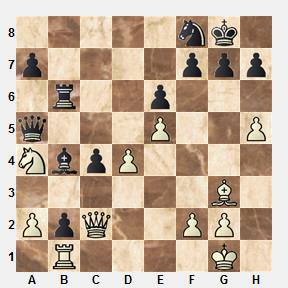Last week the British Championships started. This is a tournament I enjoy following as I knew many of the players involved. Some of the younger ones I never met as I left the UK over 10 years agao. Funnily enough, I spent years trying to qualify for the British Championship when the qualification criteria was tough. You either had to have a rating of 2320 or pick up a place from one of the qualifiers on the weekend circuit. Then, I finally qualified for the 2005 Championship, only to leave England a few months before the tournament.
No regrets though as I've made a great life here, and enjoy the chess scene in Australia. In fact, it is likely that I'll play in the upcoming
Australian Championships being held in January 2016 in Melbourne. The tournament is being run by my club, the
Melbourne Chess Club. Currently, the tournament in progress on a Monday night is the Malitis Memorial. Monday night events are longplay FIDE rated events, which is my preference. After an absence from the long game for a couple of years, my rating took a pounding on my return and dropped to a low of about 2080. I seem to have got it back together again, and my rating has jumped back up to 2161, and hopefully will jump more. Although saying that, my start in the Round Robin section of the Malitis Memorial, with 2 losses was not particularly inspiring.
The Malitis Memorial is split into 2 divisions, an 8 player Round Robin and a swiss for everyone else. This format seems to have drawn more players in (though that might just be a general upturn in chess club attendance) but I think I'd like to see a slightly different format, that I once played at the OHRA tournament in Amsterdam in the early 1990's. There they had small swiss events, 16 players, 24 players, or 32 players in rating groups. I think a 16 player, 7-round swiss would be an excellent format, and would basically split the top half and bottom half players. As I remember, the prize fund was also interesting. You earned prize money for every half point above half points. So instead of a set prize fund for the tournament, the prize fund depended on how many points you scored. This sort of system discourages players trying for draws, and rewards performance. It also spreads the prize fund out.
The Round Robin section is being dominated by IM Mirko Rujevic who has won all 3 of his games and sits a point clear already. David Cannon has 2/3, and the rest of us are floundering below. The swiss event also has a clear leader in Mehmedalija Dizdarevic who is the only player on 3/3. He is half a point ahead of Tristan Krstevski (who he plays) and Eamonn O'Molloy and then there is a big group of players on 2/3. The second tournament saw a number of late entries, and the number of players in the event has swelled to 35. Seeing the 7 round winter event has had considerably less players than that in the past, the MCC must be commended at attracting players through the door.
I was able to win my game against Simon Schmidt. Simon is a much improved player as is seen by his jump up the ratings. However, he misjudged an endgame against me and turned a draw into a loss.
Simon had offered a draw a long way back, but I soldiered on in essentially level positions up to this critical juncture. Although I had been pressing, there was never anything tangible, so I decided to go for it. 44..
b4 45.cxb4 d4
So black has created a passed pawn that is a bit dangerous in the middle of the board. Still it should be no problem for white.
46.Rf3 Kd5 This was the last chance of winning.
Now, Simon correctly took my pawns on the king side,
47.fxg5 fxg5 48.Rf5+ Ke4 49.Rxg5 d3
To understand this position, you must know that neither side can win. The idea is that white will have to sacrifice their rook for black's d-pawn but will then use their king to help their g-pawn advance causing white to sacrifice their rook back again. The b-pawns are of consequence as they can be taken at will by black. Taking all this into account, white seems to left with 2 choices. 50.Rg8 and come behind the black d-pawn, or 50.Rh5 and drop the rook to the back rank.
a.
50.Rh5? d2 51.Rh1 Rc1 wins for black
b.
50. Rg8!
50..d2! [50..Rd7 fails to 51.Re8+ Ke4 52.Re1 and white has control of the back rank]
Now there is only one move to draw
51.Re8! [51.Rd8? 52.Rc3+ Kh4 53.Rd3 builds a bridge for the pawn]
51..Kd3 52.Rd8+ Kc2
53.Kf4! White's king starts supporting his own pawn. The game would conclude with white having to sacrifice his rook when black's pawn promotes, but the g-pawn will coast white a rook back again. White has time to stop the g-pan and pick up both b-pawns.
c.
50.Kf2? This was the move that Simon played, and really my main hope of an endgame swindle.
50..Rc1! Guards the promotion square and prevents white's king from blocking the pawn. Meanwhile, black's king is in great position to worry about the g-pawn while white's king has moved to a considerably worse square. The game concluded.
51.Rg8 d2 52.Re8+ Kf4 [I think Simon had forgotten that my king could move this way after he had retreated his king. If the black king has to touch the d-file, then white would be fine as he could skewer the pawn]
53.Rf8+ Kxf4 54.Rd8 d1=Q 55.Rxd1 Rxd1 56.Ke3 Kf5 0-1
This is an important practical ending for club players to understand. This type of ending is quite frequent in games, and understanding the mechanics of it will maximise your results.
































